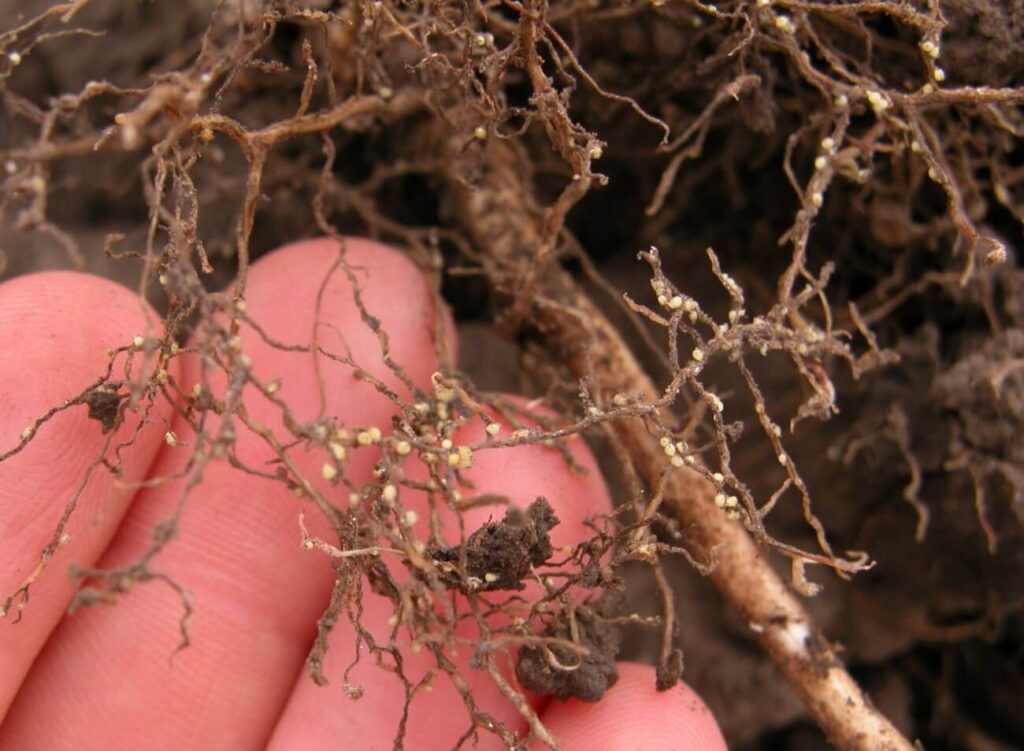Unfortunately, soybean cyst nematode (SCN) isn’t being talked about much anymore. It is known to be the #1 threat to soybean yield around the world, and in the North Central U.S., we have been depending on the PI 88788 source of resistance in 95 percent of our seed market share. A smaller percentage source of soybean resistance against SCN comes from Peking, PI 437654, or combinations. What happens when we depend on a predominate source of resistance for an extended period? SCN populations will adapt to this source of resistance and the problem becomes more serious.
Resistance isn’t new, as this was also documented in 2007 and 2008 by Mitchum, et al. and Niblack, et al., respectively. However, as SCN soil samples are screened at the university level, the problem appears to be getting worse. There has been an increase in the number of SCN populations that can survive on PI 88788, and within these populations, there are a greater number of female nematodes each of which can produce 200 to 500 eggs. Each nematode has different genes, and those that are unaffected by plant resistance can pass those genes to their offspring (by reproducing sexually). Therefore, increasing the number of SCN that are unaffected by P1 88788 read as “resistance to Race 3 and Race 14” on a bag of seed.
SCN can be difficult to diagnose because they are located within patches across a field, and symptoms may not be noticeable in favorable growing seasons with adequate rain. In cases where there are high populations, SCN cysts might be visible on roots and there could be poor nodulation, uneven soybean growth, stunted plants, or low number of pods or beans per pods. You can test for SCN for free by soil sampling and sending it off for free to the U of I Plant Clinic. You can click on the ILSoyAdvisor Survey landing page to find out more. Once the SCN sample goes to the Plant Clinic, they will sieve, process, and do SCN egg counts.
The SCN chart of thresholds and management for each SCN Egg Count per 100cc of soil can be seen below. If you have more than 5,000 eggs per 100cc of soil, you shouldn’t plant soybeans and rotate out of the crop for several years until the egg count declines. The U of I Plant Clinic test results or egg counts are based on 100cc test; however, some other labs may be based on 250cc of soil. If this is the case, the result of the test needs to be multiplied by 2.5 so that you don’t significantly underestimate the SCN population.
Another option is to have an HG (Hetorodera glycines) test on an SCN population within a field. The soil sample from your field will be tested against seven different soybean indicator lines that are given numbers 1 – 7. A female index is determined after a 30-day greenhouse test, and it is the average number of SCN females produced on the HG type indicator line relative to the number produced on a standard, susceptible soybean cultivar. Ultimately, the HG test can tell you if you have a SCN population in your field that can reproduce on a variety carrying the P1 88788 source of resistance.
The integrated management of SCN has not changed. Crop rotation to non-hosts such as corn can help, but this does not eliminate SCN populations. It just decreases them. SCN cysts can remain in the soil for several years and each cyst can contain more than 100 eggs. When they hatch, the juveniles will migrate to the plant root, set up feeding sites and steal nutrients, which can result in yield loss. SCN has also been deemed the “gateway for disease.” There are seed treatments (chemical, biological and plant-health regulators) that offer early season SCN control, but this is not considered a “stand alone” treatment. There are a limited number of varieties available that consist of an alternate form of resistance called Peking. However, Peking often is not available in fuller soybean varieties or may not come with a defense package that is right for your farm. We have come to realize that the use of a single source of resistance is not a viable long-term strategy for managing SCN, but there is hope after the recent discovery of genes underlying SCN resistance. You can learn more at Soybean Cyst Nematode, Heterodera glycines, an Update.




 and then
and then